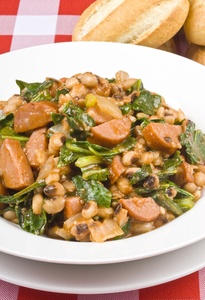Why We Ring In The New Year With Blackeyed Peas and Collard Greens
As many of you know I grew up in Germany. After I married my husband, my wonderful Mother-in-Law made sure I fixed some black-eyed peas and collards on New Year’s Day. She said the peas were for good luck and the greens for prosperity in the new year. I’ve cooked them every January 1st and thought I’d do a little research this year to see where these culinary traditions came from. I’ve come across some interesting stories and while I have no idea how historically accurate they are, I thought I’d share them with y’all today. And yes in case you’re wondering, my black-eyed peas are happily boiling away on the stove and my collards are cooking in the crockpot this year. We’ll have a couple of slices of leftover ham to round out the dinner.

Let’ start with blackeyed peas. I’ve gotta tell you… they are not my favorite and I usually make them just once a year. I enjoyed the story behind them though. In my research I’ve come across two different stories. The first one claims that after Sherman’s march through the South, many Southerners were left with only black-eyed peas and salted pork. Even though the peas were usually used as animal feed, people considered themselves lucky to have them to fill their bellies. Thus the idea that black eyed peas were lucky.
The other story I’ve found involves slaves and the Emancipation Proclamation that went into effect January 1st 1863. Blackeyed peas were a common staple in African Americans diet at the time and probably played a big part in celebratory meals that day. From this the tradition of eating them on the 1st of January may have been born.
I didn’t find a great story like that to explain why we eat collard greens. Mostly they are one of the latest crops in the south and still readily available by January 1st. The green color of this yummy veggie is associated with our green dollar bills. According to tradition, each bite of greens you eat is worth $1,000 in the coming year.
I did come across something new though that has me adding to our New Year’s Day Menu this year. I’d thought of making some biscuits to go with the ham, black-eyed peas and collards. It’s going to be switched to corn bread since there is a tradition of eating it to make sure you have plenty of spending or pocket money during the New Year. The gold color of the corn bread represents gold or coins.
I’ve had a lot of fun looking into these traditions. They make me appreciate cooking (and of course eating) this traditional New Year’s Day meal even more.
How about you? Do you have any special New Year’s Traditions? Do you cook something similar? Did you hear a different story about why we eat this stuff? Leave a comment below and let’s chat about why we ring in the New Year with black-eyed peas, collard greens and corn bread.
To support the blog, check out the HBHW eBooks available on Amazon. Thank you!
Disclosure: Some of the links below are affilate links, meaning, at no additional cost to you, I will earn a commission if you click through and make a purchase.

